Chickenpox epidemiology and demographics: Difference between revisions
(→Age) |
(→Age) |
||
| Line 33: | Line 33: | ||
===Age=== | ===Age=== | ||
*The prevalence of chicken pox decreases with age. | *The prevalence of chicken pox decreases with age. | ||
*Varicella commonly affects children less than 10 years of age. | *Varicella commonly affects children less than 10 years of age with the highest incidence among children 1-4 years of age. | ||
Revision as of 13:05, 29 June 2017
Editor-In-Chief: C. Michael Gibson, M.S., M.D. [1] Associate Editor(s)-in-Chief:
|
Chickenpox Microchapters |
|
Diagnosis |
|---|
|
Treatment |
|
Case Studies |
|
Chickenpox epidemiology and demographics On the Web |
|
American Roentgen Ray Society Images of Chickenpox epidemiology and demographics |
|
Risk calculators and risk factors for Chickenpox epidemiology and demographics |
Overview
Varicella is an endemic disease spread mainly by the respiratory route. Cases are observed all through the year but most in the winter and early spring. In tropical regions, cases of varicella infection have been reported to be more commonly among adults than children.
Epidemiology and Demographics
Prevalence
Incidence
The incidence of chicken pox varies among age groups. The incidence rates per 100,000 persons in each age group were as follow:
- For age groups 0 to 4 years 5234 per 100,000 person
- For age groups 5 to 9 years 4132 per 100,000 person
- For age groups 10 to 14 years 1404 per 100,000 person
- For age groups 15 to 19 years 610 per 100,000 person
- For age groups >20 years 175 per 100,000 person
These rates continued to decline for older age groups [1]
Case Fatality Rate
- Between the years 1990-1994, case fatality rate in the US/UK is 2-3/100,000.
- The case fatality rate among children was 1/100,000.
- The case fatality rate among adults was 20-25/100,000. [2]
Age
- The prevalence of chicken pox decreases with age.
- Varicella commonly affects children less than 10 years of age with the highest incidence among children 1-4 years of age.
- Varicella being one of the classical diseases of childhood, has a highest prevalence occurring in the age groups of less than 10 years old.
- The highest age-specific incidence of varicella was among children 1–4 years of age, who accounted for 39% of all cases. This age distribution was probably a result of earlier exposure to VZV in preschool and child care settings. Children 5–9 years of age accounted for 38% of cases. Adults 20 years of age and older accounted for only 7% of cases (National Health Interview Survey data, 1990–1994). Data from three active varicella surveillance areas indicate that the incidence of varicella, as well as varicella-related hospitalizations, has decreased significantly since licensure of vaccine in 1995.
- It is highly communicable, with an attack rate of 90% in close contacts. Occurs mostly before adulthood but 10% of young adults remain susceptible. This pattern varies by regions, eg. in rural India, varicella is predominantly a disease of adults with the mean age of infection being 23.4 years which could be due to the interference by other respiratory viruses that the children are exposed to at an early age.[3]
- From generations, varicella has been a disease predominantly affecting the preschool and school-aged children. In tropical regions, the disease noticed among adults has the characteristics of the pocks being darker and the scars being more prominent than their younger counterparts.[3]
- In the U.S., 55% of chickenpox deaths are in the over-20 age group, even though they are a tiny fraction of the cases.
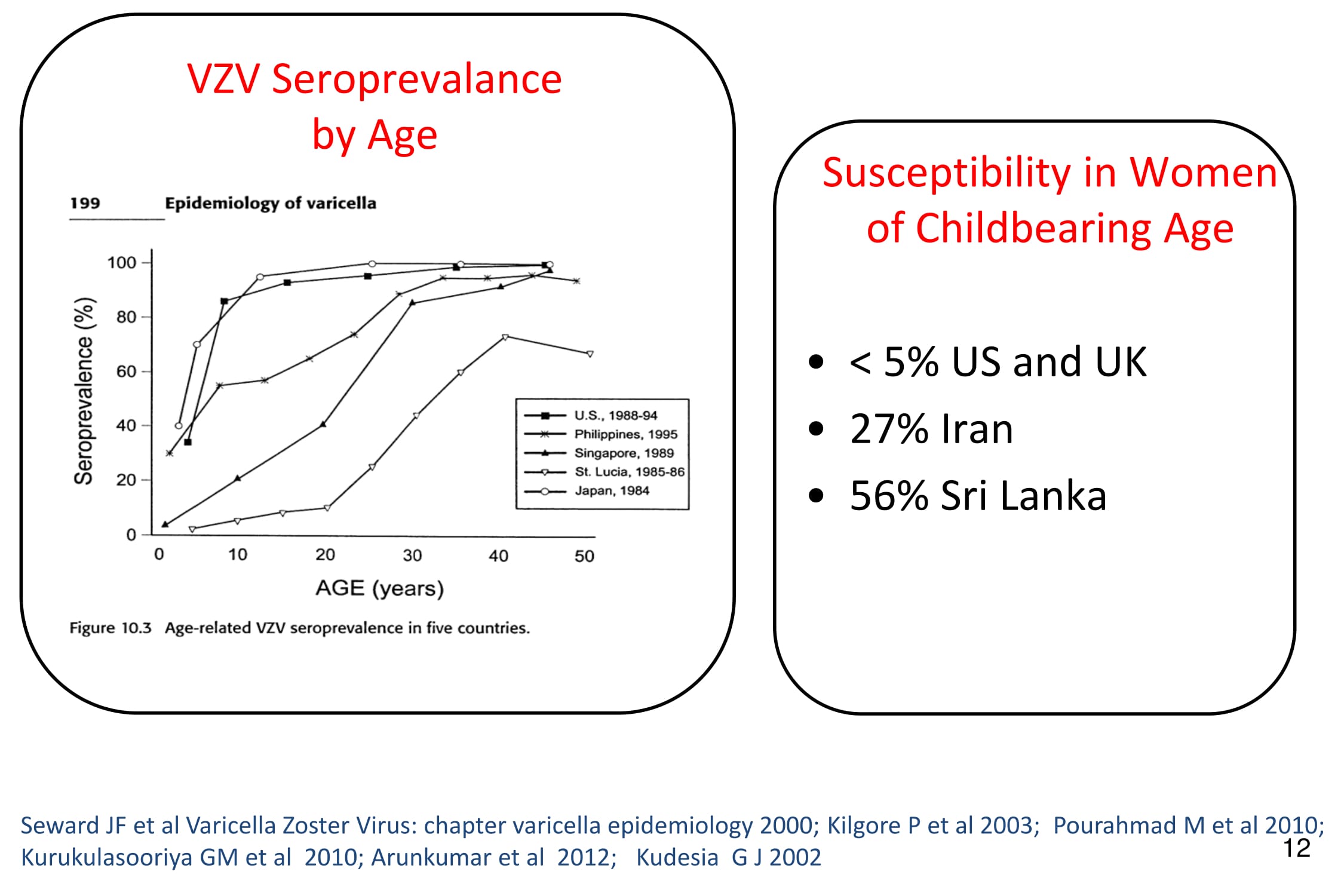
Gender
- The prevalence and incidence of chickenpox does not vary by gender. Gender differences in the incidence of chickenpox were observed in the 15-24 years age group females who are affected more comparatively. [4]
Race
- There is no racial predilection for chickenpox.
Developed Countries
The epidemiology and demographics of chickenpox in the developed countries are as follows:[2]
- Incidence
- 15.0 – 16.0/1,000 persons per year
- Highest incidence < 10 years
- Complications
- 2-4% of cases
- Hospitalizations
- 3-6 hospitalizations per 1,000 cases
- Congenital varicella syndrome
- Risk = 1-2% for pregnancies affected 0-20 weeks
- Deaths
- 3 deaths per 100,000 cases
- Most deaths occur in healthy people
Developing Countries
- Guinea Bissau 2000 (small study 2 deaths/1539 cases –6 months and 17 years) approximately 129/100,000 case, 50 times higher than US/UK.
- India late 1970s enhanced rash illness surveillance post smallpox eradication 433 deaths/862,155 reported cases; 80% deaths adults 52/100,000 cases, 20 times higher than US/UK
- Brazil 2008: estimated case fatality rate is 4/100,000. (deaths from vital statistics, cases from modeling). [2]
Deaths in hospital admissions.
- Nigeria (1970s): 14 deaths among 2,153 hospital admissions.
- Sri Lanka (2000-2001): 41 deaths among 989 varicella admissions (4.2%).
- Papua New Guinea (1980s): 10 deaths in adults at small hospital over 2 years in population 130,000.[2]
Gallery
-
-
-
-
-
-
Varicella cases and states reporting, United States, 1972-1996. From Public Health Image Library (PHIL). [5]
References
- ↑ Choo PW, Donahue JG, Manson JE, Platt R (1995). "The epidemiology of varicella and its complications". J. Infect. Dis. 172 (3): 706–12. PMID 7658062.
- ↑ 2.0 2.1 2.2 2.3 "www.who.int" (PDF).
- ↑ 3.0 3.1 "Epidemiology of Varicella Zoster Virus Infection, Epidemiology of VZV Infection, Epidemiology of Chicken Pox, Epidemiology of Shingles". Retrieved 2008-04-22.
- ↑ Fleming DM, Cross KW, Cobb WA, Chapman RS (2004). "Gender difference in the incidence of shingles". Epidemiol. Infect. 132 (1): 1–5. PMC 2870070. PMID 14979582.
- ↑ "Public Health Image Library (PHIL)".
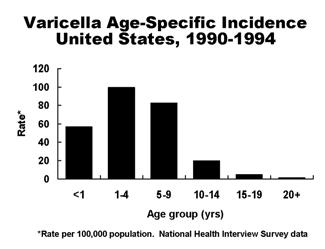
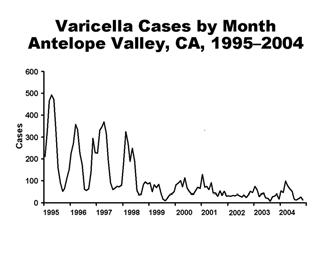
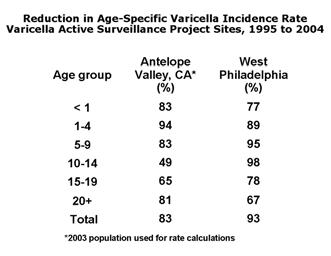
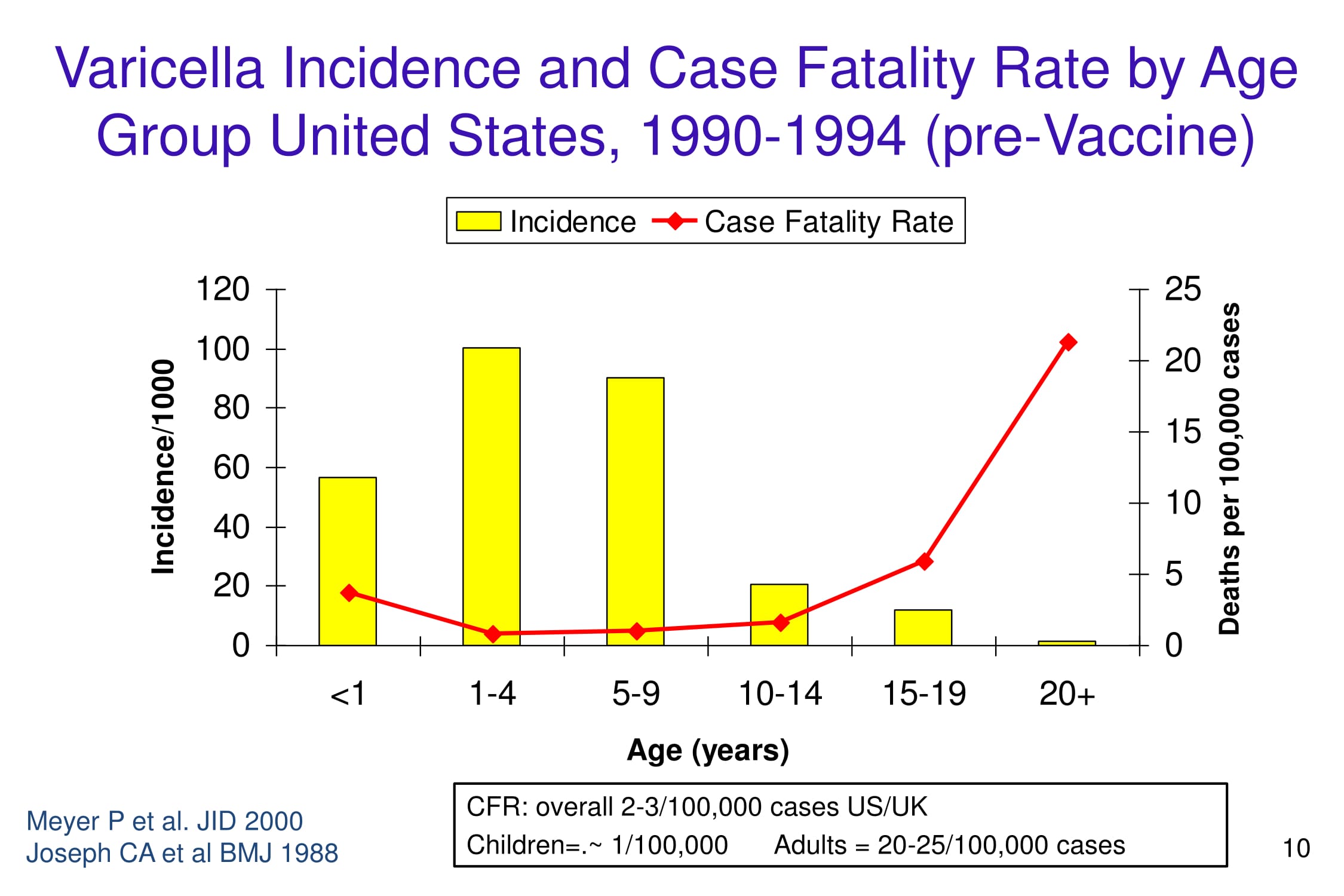
![Varicella cases and states reporting, United States, 1972-1996. From Public Health Image Library (PHIL). [5]](/images/2/26/Chickenpox40.jpeg)